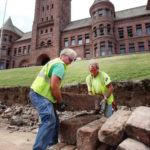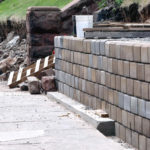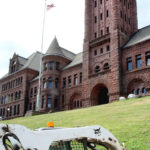cialis generika site here
Crews are busy replacing Historic Old Central High School’s retaining wall — built in the 1890s — with the hope of holding back the hillside for at least another century.
The retaining wall stretches the entire block in front of the former high school, now the Duluth public schools offices, on East Second Street and halfway up the block on each side, Lake Avenue and First Avenue East. After more than 120 years of the ground freezing and thawing, and water running down the hill, the wall began to show its age. When restoration is complete, the retaining wall’s recognizable brownstone facade — which matches the former high school behind it — will return to the way it looked in the 1890s, according to Kerry Leider, property manager for Duluth public schools.
“I think the Historical Central High School is a building that is cherished by the entire community — it’s a marquee, it’s a landmark in our community, and it’s something that deserves to be restored and repaired and preserved to the extent that it can be,” Leider said.
After carefully removing a brownstone, Hovland Inc. crews categorize and palletize it so it can later return to its original place. Then a concrete footing is poured and the new retaining wall is put in place made of concrete blocks called brutes, now visible along the east half of the block along Second Street and First Avenue East. Without the brownstone back in place, the brutes are left exposed. Their gray appearance doesn’t match the high school, which has concerned some people passing by.
“There’s been a lot of people that have asked about that concrete wall and expressing some disappointment thinking that’s what was going to be there, but that’s not the case,” Leider said.
But Dave Spooner, supervisor of maintenance and construction for the school district, said the response has been surprisingly mixed, with some actually liking the appearance of the concrete blocks, despite not matching Historic Old Central’s brownstone.
“Strangely enough, about half the people think the brutes look really nice and they thought that was the finished wall. Then when I explained that we had kept all the brownstone and documented where it was at, and that’s all going back in … they were all pretty excited,” Spooner said.
The wall was built in the 1890s with brownstone excavated either on the Apostle Islands or another quarry near Bayfield, Leider and Spooner said, but neither was certain. Since the quarries have long laid dormant, finding new stone to replace any damaged pieces is out of the question.
“It’s not exact because the stone has fractured and it’s broken in some areas, so there are going to be a few smaller pieces, but we can’t get access to that stone anymore,” Leider said. The solution, he added, is to salvage pieces of matching stone from capstones on the short wall near the gymnasium addition.
Only 6 inches of the wall could be seen, but the brownstone went rather deep underground, Spooner said. So they excavated it and salvaged about 50 feet of well-preserved brownstone on each side of Central.
100-year wall
The district used this method a decade ago when a section of the retaining wall failed on Second Street.
“We’ve had a 10-year experience with the design that we’re installing now and are confident that what we’re doing is going to allow it to be restored and function for another hundred-plus years,” Leider said.
Other than the section that collapsed a decade ago, the wall has stood since its construction, but when gutters were removed from Historic Old Central 35 years ago, more water fell onto the front yard. This, Spooner said, might have pushed the hillside against the hidden retaining wall, moving it several inches over the course of a few decades.
“When the gutters were removed, it allowed rainfall just to shed off the roof into the front yard, and we feel that whole hillside is starting to slide down the hill, pushing that hidden retaining wall over,” Spooner said.
To prevent this from occurring again, a French drain system is being installed with piping to carry water to the city’s storm sewer system.
“We’re taking the water away from the hillside via a system to prevent the water from infiltrating that hillside and continuing to slide on the ledge rock,” Spooner said.
Although improved drainage and a new retaining wall will prolong the wall’s life, the construction methods are still similar to those used more than 120 years ago on Central’s original wall.
“Means and methods have changed a bit, but it’s very similar,” said Spooner, who expects construction to be completed before the ground freezes. “When you work with bricks and mortar, things haven’t changed a whole lot in the past. I mean, it’s an art in itself.”



